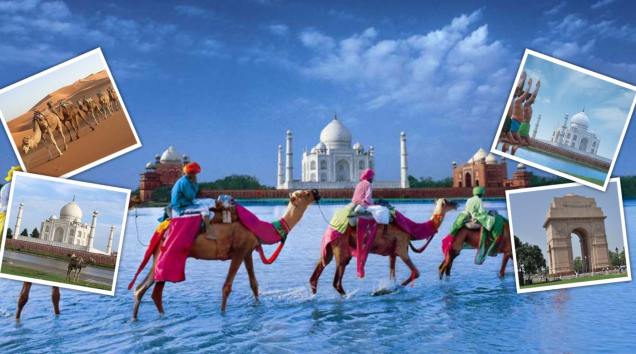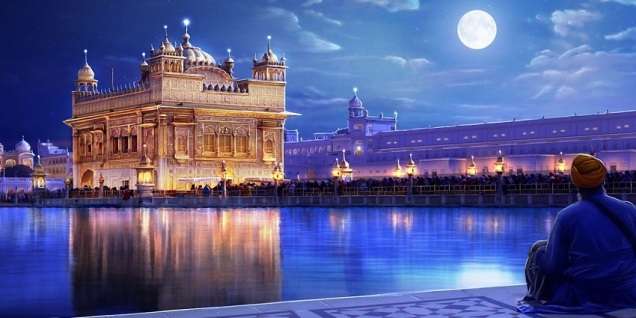“The main streets are the principal Bazaars; on each side, under the arcades of the palaces, temples and houses, are the shops of the artisans who are seen working almost in the open air at their trades: the tailors, shoemakers, goldsmiths, armourers, pastry cooks, confectioners, coppersmiths…”, wrote Victor Jacquement, a guest of the Governor General of India in 1832, in his Impressions of Jaipur and Amber.
Few other cities can offer the range of opportunity to encounter so many artisans practicing skills centuries old, and for this the credit must go to the art-loving rulers of Amber and Jaipur. They not only invited craftspeople to the city from as far as Iran, but provided the environment in which to develop and refining their arts. Jaipur’s founder, after completing his palace, concentrated his treasure on building shops and bazaars and luring traders, bankers and craftsmen from Delhi, Udaipur and other regions to settle down in Jaipur.

Golden Triangle Tour and Shopping
Over the years the crafts of Jaipur have become major earners of foreign exchange and have had an impact on the city’s economy. Rambling through the bazaars of Jaipur is an education in the 40 variety and diversity of Rajasthan’s handmade goods. – Also Visit :
Golden Triangle Tour Packages
The oldest and busiest market of the walled city is Johari Bazaar. Laid out between Sanganeri Gate and Bari Chaupar (the main square of the city), the market has temples, vegetable sellers and grocers side by side with emerald dealers. It is the main shopping area for the local people as well as an internationally known Centre of the S lapidary trade. Most of the leading dealers of precious and semi-precious stones are located either in Johari Bazaar or its by-lane, Gopalji ka Rasta. Gems and jewellery are one of the major export industries of the country, and the contribution of Jaipur’s artisans here is immense. The country imports the raw material which is then hand-cut, polished and re-ex-ported. Almost all of the country’s cutters and polishers live in the walled city of Jaipur. Employing traditional tools, they achieve perfect angles, and their dexterity turns the least promising rough stones into gems worth thousands of rupees. An outlet of the wholesaler is popularly known as a gaddi, named for the mattress on which one sits cross-legged in the traditional Indian manner. One of the best outlets for fine jewellery is the Gem Palace on M.I. Road, established in 1852. The Kasliwal brothers who run the shop have a list of clients that runs from Hollywood stars to Parisian fashion houses. They have opened a small showroom/museum above the shop, in a beautiful room decorated using traditional techniques.

Inlay of gems in gold jewellery in the style referred to as Kundan has been exclusively practised in Jaipur. One of the best-known dealers is located in Haldiyon ka Rasta, another by-lane of Johari Bazaar: the dazzling shop of Bhuramal Rajmal Surana is romantically housed in a medieval mansion. Closely linked with Kundan is the art of enameling which travelled from Persia via Lahore. Of the five Sikh enamellers brought to Jaipur by Raja Man Singh I in 16th century, the descendants of one continue to practice the art in a narrow lane—Jadiyon ka Rasta. Sardar Kudrat Singh is a master craftsman of the art of enameling and has several inter-national awards to his credit. The artist is willing to display his pieces at his place of work — which happens also to be his home.
Another art which flourished in Johari Bazaar is tie-dying. Though the artists practice their craft in their colonies some distance away, Johari Bazaar itself is the major outlet for their creations. A large portion of the market is occupied by dealers in tie-dyed textiles. The Rangrez, the traditional Muslim community of Jaipur dyers, have included various techniques in their creations but they are famous for laharia – the striped tie-dye — and mothra, a criss-cross pattern, both customarily worn for the monsoon festival of Tij.
Also on Johari Bazaar is Rana Saree, a family business which has been dealing in fabrics for over 250 years. This is an excellent place to find zardosi-work saris — silk saris elaborately embroidered with gold and silver thread.
Passing through the square of Bari Chaupar offers a vivid glimpse of local life: flower sellers, shops of attar, and dealers in traditional silver jewelry and block printed textiles throng the area. On one side, under a banyan tree, are wayside shops selling simple but beautiful bangles, local shoes and rustic jewelry. There are tailors here who can stitch traditional dresses within hours of order. A road from the square leads to the Ramganj Bazaar, known for the hand-crafted slip-on shoes called juti. A fascinating range of traditional shoes from all over Rajasthan is available here. The most comfortable are made of camel hide. From this road the settlement of the dyers can be approached, if one is interested in witnessing the intricate process of tie-dying.

Explore: Information on Arts and Crafts of Rajasthan
Past the square, all around Hawa Mahal is the tourist market. Shops have sprung up like mushrooms with the advent of tourism. Here, you can buy embroidery, gems and jewelry, jutis and curios, but tourists should be on guard against poor quality and over-priced goods. Ahead, a labyrinth on the right of Subhash Chowk unfolds the world of carpets and durri weavers. Jaipur is an exporter of a large number of carpets and rugs. An outlet with a good reputation for quality is Maharaja Carpets based in Samode Haveli.
Jaipur markets are overflowing with miniature paintings on paper, silk and ivory, predominantly reproductions of old masterpieces. A careful eye is required to differentiate the painting of a skilled miniature artist from one produced in the mass production factories. Some painters excel in painting on ivory, but with the worldwide restriction on ivory they are switching to the traditional medium of paper. These can be seen at The Collection Painting School on Mount Road, and at the Friends of the Museum Master Craftsmen and Artists in the City Palace (this is also a good place to see traditional tie-dyed fabrics and hand-made paper).
A more contemporary view of Rajasthani life can be seen in the paintings of Jaya Wheaton, who can be contacted at C80 Subhas Marg. Her work is distinguished by the use of just one or two complementary colors.
There are particular crafts which are identified with particular areas of the walled city. The Silawats or marble sculptors have been practicing this art since the inception of Jaipur in the lane named after them, Silawaton ka Rasta, also referred to as the Khazne Walon ka Rasta. The craftsmen have excelled in sculpting, single marble slabs into images of the deities of Hindu pantheon, adhering to the principles laid out in the ancient canons. One of the principles requires them to abandon the unfinished statue if it should undergo any damage. Hindu temples all over the country and overseas have installed statues carved by the Jaipur Silawats. Today they make statues to order as well as intricate marble arches, balconies and wall panels. One of the best places to see marble carving is Shashi Arts and Crafts, a family-run business that has been producing work in the same haveli for over 150 years.
Turning lac bangles is another colorful craft of Jaipur. The lac bangle makers, known as Manihars, inhabit Maniharon ka Rasta. Lac bangles are of great significance in the life of Rajasthani people: women are given special bangles on auspicious occasions such as marriage and childbirth. Some of the bangle makers here also make designer jewellery for the export market.
Certain other crafts patronized by the former rulers of Jaipur flourish beyond the walls of the city. These include block printed textiles, blue pottery and paper making. Near the airport lies the village of Sanganer, well known for its block printed textile and handmade paper. It also has a blue pottery factory.
The ceramics artist Kripal Singh Shekhawat was largely responsible for reviving the art that was brought to Jaipur by Sawai Ram Singh II. His creations, adhering to traditional skills and shapes, are on sale at Kripal Kumbh on Shir Marg in Bani Park. Other outlets for blue pottery, also interesting, are the Blue Pottery Art Centre on Amer Road, and Neerja International on Bhawani Singh Marg. The ensemble of crafts of Rajasthan has been presented under one roof by the government-sponsored emporium Rajasthali, just off M.I. Road — this is the way government-approved store. You can shop there at a fixed price.
If you planning to explore Golden Triangle Tour Book Delhi, Agra and Jaipur tour packages Swan Tours India and get exciting offers,Swan Tours one of the leading travel agents in India.
SWAN TOURS
Gaurav Chawla.
Director.
F-6, Second Floor, Shankar Market, Connaught Place, New Delhi – 110001
Telephone: 011 23415601, Mob. 9810100293
E-mail: gaurav.chawla@swantours.in Visit us at: http://www.swantour.com
















